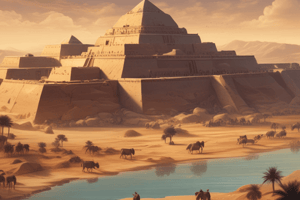Podcast
Questions and Answers
Where is Mesopotamia located?
Where is Mesopotamia located?
- In the Yangtze River Delta
- Between the Nile and Euphrates rivers
- Between the Tigris and Euphrates rivers (correct)
- In the Indus Valley Civilization
What was the main feature of the climate in Mesopotamia?
What was the main feature of the climate in Mesopotamia?
- Cool and windy
- Cold and humid
- Hot and dry (correct)
- Temperate and moderate
Which of the following was an achievement of Mesopotamia?
Which of the following was an achievement of Mesopotamia?
- Building the Great Pyramid of Giza
- Developing the hieroglyphic writing system
- Creating a system of democracy
- Inventing the wheel (correct)
During which period did the pharaohs of Egypt focus on military campaigns, literature, and art?
During which period did the pharaohs of Egypt focus on military campaigns, literature, and art?
Which pharaoh built the Bent Pyramid?
Which pharaoh built the Bent Pyramid?
What was the Valley of the Kings used for?
What was the Valley of the Kings used for?
Which Mesopotamian empire rose and fell, with periods of unification and fragmentation?
Which Mesopotamian empire rose and fell, with periods of unification and fragmentation?
Who was the pharaoh who introduced monotheistic worship of Aten?
Who was the pharaoh who introduced monotheistic worship of Aten?
Flashcards are hidden until you start studying
Study Notes
Mesopotamia
Geography and Climate
- Located in the Fertile Crescent, between the Tigris and Euphrates rivers
- Climate: hot and dry, with flooded rivers making agriculture possible
City-States and Empires
- City-states: Ur, Uruk, Nippur, and Babylon
- Empires: Sumerian, Akkadian, Babylonian, and Assyrian
- Each empire rose and fell, with periods of unification and fragmentation
Achievements
- Invented the wheel (circa 4000 BCE)
- Developed cuneiform writing (circa 3500 BCE)
- Created complex systems of governance and administration
- Made significant advances in mathematics, architecture, and law
Egyptian Pharaohs
Old Kingdom (2613-2181 BCE)
- Pyramids of Giza, built during the reign of Khufu, Khafre, and Menkaure
- Pharaohs considered gods, with absolute power and authority
- Economy based on agriculture, with a strong centralized government
Middle Kingdom (2040-1750 BCE)
- Period of relative stability and cultural flourishing
- Pharaohs focused on military campaigns, literature, and art
- Trade and cultural exchange with neighboring regions
New Kingdom (1570-1085 BCE)
- Pharaohs Hatshepsut, Thutmose III, and Ramses II
- Empire reached its peak, with extensive trade networks and military conquests
- Valley of the Kings, a necropolis for pharaohs, was built during this period
Pharaonic Dynasties
- 30 dynasties, with some notable pharaohs:
- Narmer (unified Upper and Lower Egypt)
- Sneferu (built the Bent Pyramid)
- Hatshepsut (successful trader and builder)
- Akhenaten (introduced monotheistic worship of Aten)
- Tutankhamun (famous for his tomb discovery)
Mesopotamia
Geography and Climate
- Mesopotamia located in the Fertile Crescent, between the Tigris and Euphrates rivers
- Climate: hot and dry, with flooded rivers allowing for agriculture
City-States and Empires
- City-states: Ur, Uruk, Nippur, and Babylon existed in Mesopotamia
- Empires: Sumerian, Akkadian, Babylonian, and Assyrian rose and fell
- Periods of unification and fragmentation occurred between empires
Achievements
- Invention of the wheel circa 4000 BCE revolutionized transportation
- Development of cuneiform writing circa 3500 BCE enabled written records
- Complex systems of governance and administration were established
- Significant advances made in mathematics, architecture, and law
Egyptian Pharaohs
Old Kingdom (2613-2181 BCE)
- Pyramids of Giza built during the reign of Khufu, Khafre, and Menkaure
- Pharaohs considered gods, holding absolute power and authority
- Economy based on agriculture, with a strong centralized government
Middle Kingdom (2040-1750 BCE)
- Period of relative stability and cultural flourishing
- Pharaohs focused on military campaigns, literature, and art
- Trade and cultural exchange with neighboring regions occurred
New Kingdom (1570-1085 BCE)
- Pharaohs Hatshepsut, Thutmose III, and Ramses II ruled during this period
- Empire reached its peak, with extensive trade networks and military conquests
- Valley of the Kings, a necropolis for pharaohs, was built during this period
Pharaonic Dynasties
- 30 dynasties occurred, with notable pharaohs including:
- Narmer, who unified Upper and Lower Egypt
- Sneferu, who built the Bent Pyramid
- Hatshepsut, a successful trader and builder
- Akhenaten, who introduced monotheistic worship of Aten
- Tutankhamun, famous for his tomb discovery
Studying That Suits You
Use AI to generate personalized quizzes and flashcards to suit your learning preferences.




